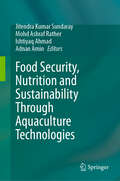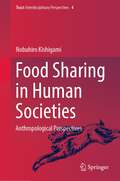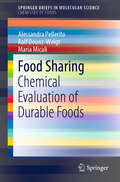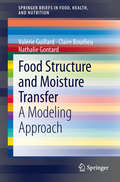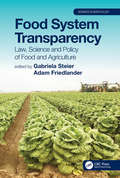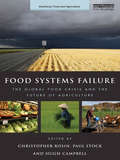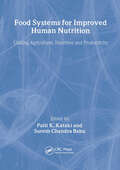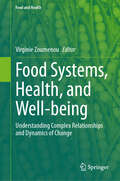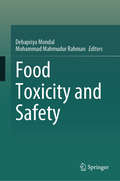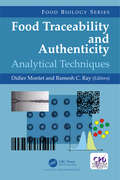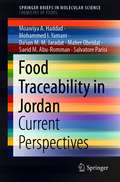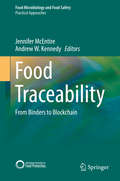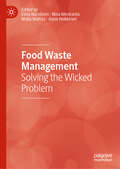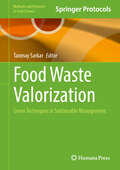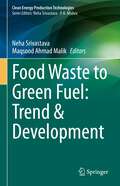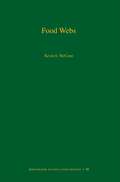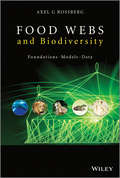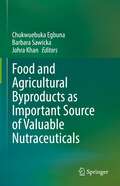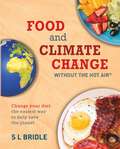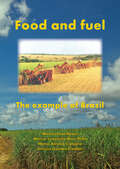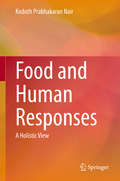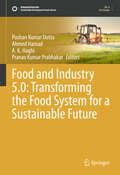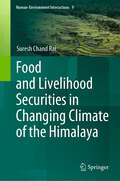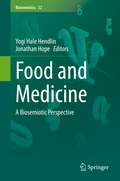- Table View
- List View
Food Security, Nutrition and Sustainability Through Aquaculture Technologies
by Jitendra Kumar Sundaray Mohd Ashraf Rather Adnan Amin Ishtiyaq AhmadAquaculture is the farming of aquatic organisms such as fish, crustaceans, mollusks and aquatic plants. It is a rapidly growing industry that plays a significant role in providing food security, improving nutrition and promoting sustainability. Food security is a major global concern, with millions of people around the world suffering from malnutrition and hunger. Food security, nutrition and sustainability are global challenges that need urgent attention to achieve a better and more sustainable future. Aquaculture technologies can help to address this problem by increasing the availability and accessibility of fish and other aquatic foods, providing a source of protein-rich food, improving nutrition, enhancing sustainability, generating income and improving food safety. In addition, aquaculture technologies play an important role in promoting nutrition. Fish and other aquatic foods are a good source of essential nutrients that are important for human health, including omega-3 fatty acids, vitamin D and minerals like iron and zinc. By increasing access to these foods, aquaculture can help to improve nutrition and reduce the incidence of diet-related diseases. Fish and shellfish are rich in omega-3 fatty acids, which have been linked to improved heart health, brain function and other health benefits. By incorporating fish and shellfish into their diets, people can improve their overall nutritional intake and reduce the risk of chronic diseases. Food Security, Nutrition and Sustainability Through Aquaculture Technologies shines a light on how aquaculture technologies contribute to sustainability by providing a more efficient and environmentally friendly way of producing food. Compared to traditional fishing practices, aquaculture can reduce pressure on wild fish populations and minimize the negative impact of fishing on marine ecosystems. Additionally, advances in aquaculture technology have led to the development of more sustainable and efficient production systems, including recirculating aquaculture systems and integrated multi-trophic aquaculture. As the global population continues to grow, demand for protein-rich foods like fish is increasing. Aquaculture provides a sustainable way to meet this demand, as it can produce more protein per unit of feed than traditional livestock farming. This book discusses aquaculture practiced in areas where traditional agriculture is not feasible, such as regions that are unsuitable for crop production. In addition to providing a source of protein, aquaculture can also improve nutrition. Aquaculture can be practiced in a sustainable manner, with minimal impact on the environment. Unlike traditional fishing, which can deplete wild fish populations and damage marine ecosystems, aquaculture allows for the controlled cultivation of fish and other aquatic organisms. Properly managed aquaculture operations can also minimize waste and pollution and caneven contribute to ecosystem restoration by providing habitat for marine species. This book includes chapters on various aspects of aquaculture technologies that address a range of important global challenges including food security, nutrition and sustainability and are likely to play an increasingly important role in meeting the world's growing demand for food.
Food Sharing in Human Societies: Anthropological Perspectives (Trust #4)
by Nobuhiro KishigamiThis book explores why human beings share food with others using a humanistic anthropological approach. This book provides a comparative examination of distinct features and historical changes in food-sharing practices in various hunting-gathering societies, especially in the Inuit. The author considers human nature through various human food-sharing practices. Food sharing is a characteristic of human behavior and has been one of the central topics in anthropological studies of hunter-gatherers for a long time. While anthropologists have attempted to understand it in functional, historical, adaptational, social, cultural, psychological, or phenomenological perspective, they have failed to convincingly explain its origin, variation, existence or/and change. Recently, evolutionary ecology or behavioral ecology has dominated research of the topic. However, neither of them adequately considers social, cultural and historical factors in the analysis of human food-sharing practices. This book is an essential and fundamental study for every researcher interested in the relationship between human nature, society and culture.
Food Sharing: Chemical Evaluation of Durable Foods (SpringerBriefs in Molecular Science)
by Maria Micali Alessandra Pellerito Ralf Dounz-WeigtThis book presents the concept of food sharing from a European perspective, and provides a concise analysis of its safety implications and the chemical properties of recovered foods.In our modern world, 33% of the total food produced is lost each year, with serious economic, environmental and social consequences. Food worth approximately 1 trillion USD is wasted per year, and it is estimated that this wasted food could feed more than 3.4 billion people. Considering that 1/10 of the global population still does not have enough money for basic needs, and in view of the impact of consumer behaviour, food retailers and industry in food waste, food sharing appears to be an attractive solution, and several communities have recently been created with the main goal of saving food and giving it to those in need. Despite the positive impact of food sharing, it also raises concerns since recovered foods are subject to spoilage, decay and irreversible chemical-physical transformations.In this book, the authors explore the current situation and the regulatory definition of food sharing in various European countries, presenting the German experience in the city of Magdeburg, where food-sharing networks have been implemented. They also discuss the chemical and safety evaluations of durable foods, and provide a simulation of food waste by comparing a food product with the same food produced with re-worked and still edible raw materials (recovered foods).
Food Structure and Moisture Transfer
by Nathalie Gontard Valérie Guillard Claire BourlieuIt's well known that the structural characteristics of food materials influence their mass transfer, especially their water transfer properties during such processes as drying, hydration, and storage. In porous cereal-based products, for example, effective water diffusivity is highly affected by the volume fraction and distribution of both solid and gas phases, while in dense food materials, such as fat-based or other edible coatings, it depends on factors that affect the "tightness" of the molecular structure (e.g., free volume, cohesive energy density, crystallinity). This Brief will review the impact of food structure on moisture transfer. A multi-scale analysis of food structure will include a look at molecular structure (e.g., free volume, crystallinity), nanostructure, microstructure (e.g., porous food), and macrostructure (e.g., bilayer structure). For each structural analysis, a focus on the mathematical modelling of the relationship between structural properties and moisture transfer properties will be performed.
Food System Transparency: Law, Science and Policy of Food and Agriculture (Advances in Agroecology)
by Gabriela Steier Adam FriedlanderThis book brings together an international group of agriculture and food lawyers and scientists to define the field of Food System Transparency in three parts: the big picture, food safety and health, and the global view. Each part adds to the whole but zooms in through a unique lens. Investigating social, economic, political, scientific and legal frameworks, this comprehensive volume addresses topics such as food authenticity, agroecological evaluations, and consumer protection. Interwoven themes of transparency contextualize concepts of food safety, information sharing and regulatory opportunities at a local and global scale. Editors’ notes provide blended legal and scientific commentary to facilitate further discussion and context within the classroom. Advantages of this volume include: Chapters written by foremost international experts in their fields Editors’ notes written for classroom use and background information Figures and tables providing illustrations of important concepts Case studies delivering practicality and in-depth analysis to current events A special chapter on COVID-19 and its implications for the food system This book is important reading for graduate-level students, legal scholars, nonlegal academics, advocates for food system transparency and resilience, agroecology and environmental conservation, and practitioners in any cross-disciplinary areas relating to food policy. It will be of interest to all those who seek to deepen their understanding of the concepts and trends surrounding the information that centers around our food system, both domestically in the United States and the European Union, as well as in many major trading nations such as China.Check out the Support Materials tab on www.routledge.com/9780367440367 for a short video previewing some the key themes in the book.
Food Systems Failure: The Global Food Crisis and the Future of Agriculture (Earthscan Food and Agriculture)
by Hugh Campbell Paul Stock Christopher RosinThis book provides a critical assessment of the contemporary global food system in light of the heightening food crisis, as evidence of its failure to achieve food security for the world's population. A key aspect of this failure is identified in the neoliberal strategies which emphasize industrial efficiencies, commodity production and free trade-ideologies that underlie agricultural and food policies in what are frequently referred to as 'developed countries'. The book examines both the contradictions in the global food system as well as the implications of existing ideologies of production associated with commodity industrial agriculture using evidence from relevant international case studies. The book's first section presents the context of the food crisis with contributions from leading international academics and food policy activists, including climate scientists, ecologists and social scientists. These contributions identify current contradictions in policy and practice that impede solutions to the food crisis. Set within this context, the second section assesses current conditions in the global food system, including economic viability, sustainability and productivity. Case study analyses of regions exposed to neoliberal policy at the production end of the system provide insights into both current challenges to feeding the world, as well as alternative strategies for creating a more just and moral food system.
Food Systems for Improved Human Nutrition: Linking Agriculture, Nutrition and Productivity
by Suresh Chandra Babu Palit KatakiLearn to produce crops with improved nutrition to alleviate malnourishment--using sustainable agriculture techniques!Utilizing complete food systems to improve nutrition has become a priority in the fight against malnutrition. This book examines all aspects of food systems, drawing on examples from various countries and geographical regions. Bringing together the most recent work of international experts, Food Systems for Improved Human Nutrition provides an important overview of the food systems approach. It also explores the extent of malnourishment in different areas; presents case studies from South Asia, China, India, Bangladesh, and East Africa; points to ways to improve food production and nutrient quality; and suggests directions for future research. Helpful charts and tables make the information in this well-referenced book easy to access and understand.Food Systems for Improved Human Nutrition brings you state-of-the-art information on: the potential benefits of agroforestry systems how to fortify food with micronutrients how to design population-appropriate nutrition interventions the ways that rapid economic change can affect human nutrition in a given area biotech approaches to improve nutrition in rice and maize crops crossbred cow technologies in the East African highlands and much more!
Food Systems, Health, and Well-being: Understanding Complex Relationships and Dynamics of Change (Food and Health)
by Virginie ZoumenouWhile the importance of food to health and well-being is clear, the specific ways in which food systems contribute to individual and community health are not well understood. This is a complex issue, which requires improving food systems as well as changing mindsets and behaviors of individuals within the food system. Many of the food-related health problems in the US disproportionately affect children, women, ethnic minorities, and low-income people. Addressing these problems requires that we understand more about the processes of institutional change, structural conditions, perceptions, and decision-making processes. The environment itself determines much of what individuals can draw from it. Community norms may dictate who has access to food assistance; engaged communities may provide more food assistance and may make food resources more easily accessible for the poor. In addition, consumer and producer attitudes and interests may conflict over some issues surrounding sustainability and health. The present volume focuses on food production, distribution and consumption, and their effects on individual health. The text is divided into three parts: Part One focuses on the relationship between food systems, families, health, sociodemographic and environmental factors; Part Two explores the relationship between food systems, food advertisements, and community engagement; and Part Three discusses current research and interventions toward a more equitable food system.
Food Toxicity and Safety
by Debapriya Mondal Mohammad Mahmudur RahmanThis book comprises 15 chapters contributed by scientists and experts from countries including Australia, India, Peru, USA, UK, and Zimbabwe and is divided into four sections. Section I of the book deals with the challenges in food safety such as chemical contaminants, nanoparticles used in agriculture in form of fertilizers and pesticides, microplastics, organic pollutants like perfluoro-octane sulphonate and consist of six chapters. Section II is dedicated to heavy metal contamination in food such as high cadmium exposure and associated health risks and contains four chapters. Section III includes four chapters that highlight arsenic contamination in the food and food chain system—a serious threat to food security and human health. To summarize and provide a way forward, a chapter has been included in Section IV. The book is an informative source of reference to the researchers and scientists working in the area of food science and technology, food regulators, policymakers, producers, healthcare providers, educators, consumers, and other stakeholders.
Food Traceability and Authenticity: Analytical Techniques (Food Biology Series)
by Didier Montet Ramesh C. RayFood traceability is a growing consumer concern worldwide. Traceability is undertaken primarily at the administrative level, where the use of advanced analytical tools is not available. Nevertheless, the determination of geographical origin is a requirement of the traceability system for the import and export of foodstuffs (EU regulation 178/2002). The topics covered in this book include the history of traceability; legislations and rules; the actual traceability techniques and the potential analytical techniques for food traceability such as molecular methods (e.g. DGGE, SSCP), next generation sequencers (NGS), bio-captors, chromatographic techniques, isotopic analysis that are used for discrimination of organic food, fish, oils. The chromatographic techniques help in the use of volatile compounds analysis. The isotope analysis helps in distinguishing between chicken meat and vegetable oils. Ambient mass spectrometry is used for studying mycotoxines and alkaloids in foodstuffs and their management, food and feed authentication in olive and other plant oils, and wine. Vibrational methods (e.g. NMR and NIRS) are used to trace food by global spectrum. The book reviews the current and future techniques including metabolomic techniques.
Food Traceability in Jordan: Current Perspectives (SpringerBriefs in Molecular Science)
by Salvatore Parisi Moawiya A. Haddad Mohammed I. Yamani Da'san M.M. Jaradat Maher Obeidat Saeid M. Abu-RommanThis book outlines the evolution of food traceability matters in the current traditional foods market and particularly with regard to selected historical foods based in Jordan.At present, traceability is just one of the many requirements the food industry is forced to meet. The topic can be approached from various angles: regulation, technological perspectives, food business operators, packaging manufacturers, software producers, and consumer views. In addition, traceable food products provide an interesting legacy for many geographical and ethnic cultures. Consequently, the examination of certain recipes or food products linked with history and traditions can make a unique and valuable contribution to future developments in this area.In this regard, Jordanian foods offer a prime example. This book examines three traditional products from different viewpoints, paying special attention to their chemical composition, the identification of raw materials, preparation procedures, and traceability. The book begins with a more general discussion on food traceability without detailed regional implications, while the second chapter discusses the product hummus in its many versions. In turn, the third and fourth chapters focus on two fermented dairy products, labaneh and jameed, and their connections with the Mediterranean diet. The book offers a valuable reference guide to many traditional/historical products in the Middle East, with a particular focus on traceability matters and solutions.
Food Traceability: From Binders to Blockchain (Food Microbiology and Food Safety)
by Jennifer McEntire Andrew W. KennedyThis book provides a picture of food traceability for all aspects of the food system, recognizing the unique differences, challenges, and “states of the industry” in different types of food products, as well as the different pressures and opportunities at different points in the supply chain and the research that has already been done. It also provides some historical context, along with the types of solutions available to the food industry, and the benefits associated with better recordkeeping that go beyond the public good and impact the bottom line. Whenever a food related outbreak occurs, traceability is called into question. When lives are at stake, it is critical that the root of the problem is quickly identified to prevent further illness. Once the problem is found, it’s just as important to contain it quickly. Too often, recalls expand because implicated product is not readily accounted for. Mention of traceability stirs fear for many in the food industry for several reasons: within a company, it’s not clear if responsibility for traceability lies with food safety professionals involved in recalls, supply chain professionals who understand product movement, IT professionals who build and maintain the recordkeeping systems, or regulatory professionals who need to respond to government requests for information. There is also a sense that traceability is someone else’s problem. Few firms admit that they are the weak link and instead tout how quickly they can perform mock recalls. But traceability is about more than just recalls. It is about the connectivity of the supply chain as a product and its constituents travel from the farm to the consumer. Because it is a systems issue, there is a sense that the investment by a single firm will be meaningless if supply chain partners don’t have comparable abilities. This book will address both these surrounding issues and solutions.
Food Waste Management: Solving the Wicked Problem
by Elina Närvänen Nina Mesiranta Malla Mattila Anna HeikkinenThis book focuses on the crucial sustainability challenge of reducing food waste at the level of consumer-society. Providing an in-depth, research-based overview of the multifaceted problem, it considers environmental, economic, social and ethical factors. Perspectives included in the book address households, consumers, and organizations, and their role in reducing food waste. Rather than focusing upon the reasons for food waste itself, the chapters develop research-based solutions for the problem, providing a much-needed solution-orientated approach that takes multiple perspectives into account.Chapters 1, 2, 12 and 16 of this book are available open access under a CC BY 4.0 license at link.springer.com
Food Waste Valorization: Green Techniques in Sustainable Management (Methods and Protocols in Food Science)
by Tanmay SarkarThis volume provides an extensive exploration of innovative and sustainable methodologies for addressing food waste challenges. Chapters detail multiple dimensions, ensuring a comprehensive understanding of food waste valorization through green technologies. Written in the format of the Methods and Protocols in Food Science series, chapters list necessary materials and methods for readily reproducible protocols. Authoritative and cutting-edge, Food Waste Valorization: Green Techniques in Sustainable Management aims to be a valuable resource for academics, researchers, industry professionals, and students focused on sustainable food systems and waste management innovations.
Food Waste to Green Fuel: Trend & Development (Clean Energy Production Technologies)
by Neha Srivastava Maqsood Ahmad MalikThis edited book covers all the existing possibilities of using food waste as a potential, alternative and ‘ready to use’, feed stock for biofuels production. Moreover, it also presents all the sustainable and economically feasible biofuels option with their details strategies, mechanism, advantages, draw backs and future scope. It also explores in depth knowledge of food waste, and details the processing as well as opportunities to utilize it at for mass scale biofuels production. The practical feasibility and economic sustainability of biofuels production is still suffering with its cost intensity and lack of rigorous scientific strategies as well as inputs to explore it on further at upscale level. Low cost, carbon rich, economic and environmental friendly feedstock, may have strong possibilities to reduce the overall biofuels production cost and the book is based on this strategy. The book is of interest to academicians and researchers interested in industries related to biofuels production, food processing industries and industries related to waste valorization.
Food Webs (Monographs in Population Biology #50)
by Kevin S. McCannHuman impacts are dramatically altering our natural ecosystems but the exact repercussions on ecological sustainability and function remain unclear. As a result, food web theory has experienced a proliferation of research seeking to address these critical areas. Arguing that the various recent and classical food web theories can be looked at collectively and in a highly consistent and testable way, Food Webs synthesizes and reconciles modern and classical perspectives into a general unified theory. Kevin McCann brings together outcomes from population-, community-, and ecosystem-level approaches under the common currency of energy or material fluxes. He shows that these approaches--often studied in isolation--all have the same general implications in terms of population dynamic stability. Specifically, increased fluxes of energy or material tend to destabilize populations, communities, and whole ecosystems. With this understanding, stabilizing structures at different levels of the ecological hierarchy can be identified and any population-, community-, or ecosystem-level structures that mute energy or material flow also stabilize systems dynamics. McCann uses this powerful general framework to discuss the effects of human impact on the stability and sustainability of ecological systems, and he demonstrates that there is clear empirical evidence that the structures supporting ecological systems have been dangerously eroded. Uniting the latest research on food webs with classical theories, this book will be a standard source in the understanding of natural food web functions.
Food Webs and Biodiversity
by Axel G. RossbergFood webs have now been addressed in empirical and theoretical research for more than 50 years. Yet, even elementary foundational issues are still hotly debated. One difficulty is that a multitude of processes need to be taken into account to understand the patterns found empirically in the structure of food webs and communities. Food Webs and Biodiversity develops a fresh, comprehensive perspective on food webs. Mechanistic explanations for several known macroecological patterns are derived from a few fundamental concepts, which are quantitatively linked to field-observables. An argument is developed that food webs will often be the key to understanding patterns of biodiversity at community level. Key Features: Predicts generic characteristics of ecological communities in invasion-extirpation equilibrium.Generalizes the theory of competition to food webs with arbitrary topologies.Presents a new, testable quantitative theory for the mechanisms determining species richness in food webs, and other new results.Written by an internationally respected expert in the field. With global warming and other pressures on ecosystems rising, understanding and protecting biodiversity is a cause of international concern. This highly topical book will be of interest to a wide ranging audience, including not only graduate students and practitioners in community and conservation ecology but also the complex-systems research community as well as mathematicians and physicists interested in the theory of networks. "This is a comprehensive work outlining a large array of very novel and potentially game-changing ideas in food web ecology."Ken Haste Andersen, Technical University of Denmark "I believe that this will be a landmark book in community ecology ... it presents a well-established and consistent mathematical theory of food-webs. It is testable in many ways and the author finds remarkable agreements between predictions and reality."Géza Meszéna, Eötvös University, Budapest
Food and Agricultural Byproducts as Important Source of Valuable Nutraceuticals
by Chukwuebuka Egbuna Barbara Sawicka Johra KhanFood and agricultural by-products are leftovers or wastes from parts of foods, fruits, vegetables and animal sources which are obtained after processing. Agricultural by-products includes peels and rinds from citrus fruits, pineapple, mango, and banana. Other notable ones are pomace from apple, olive, red beet, and those from wine making. Also, whey from milk, straws, hulls, and brans from grains are among top agricultural by-products. These by-products often impact the environment and the social-economic sectors when they are disposed. But with the recent advances in biotechnology and scientific research, scientists have found usefulness in some of these byproducts as sources of valuable nutraceuticals, a term used to refer to chemical entities present in foods that has the propensity to impact health for disease prevention and treatment. This book entitled ‘Food and agricultural by-products as important source of valuable nutraceuticals’ presents detailed information about major agricultural byproducts that are rich in nutraceuticals. The nature and the type of nutraceuticals that they contains and their health promoting benefits were presented. The editors and chapter contributors are renowned experts from key institutions around the globe. This book will be useful to students, teachers, food chemists, nutritionists, nutritional biochemists, food biotechnologists among others. Key features Ø Highlights the health promotion benefits of nutraceuticals Ø Presents information on agrifood by-products as sources of nutraceuticals Ø Discusses functional nutraceuticals from peels, rinds, pomace, hull, bran etc
Food and Climate Change without the hot air: Change your diet: the easiest way to help save the planet (without the hot air #8)
by S L Bridle• 25% of greenhouse gas emissions come from food – how can we reduce this? • What effect does the food we eat have on the environment? • How will climate change affect the food we will eat in the future? • Can the choices we make as consumers reduce carbon emissions dramatically? Inspired by the author's former mentor David MacKay (Sustainable Energy Without the Hot Air), Food and Climate Change is a rigorously researched discussion of how food and climate change are intimately connected. In this ground-breaking and accessible work, Prof Sarah Bridle focuses on facts rather than emotive descriptions. Highly illustrated in full colour throughout, the book explains how anyone can reduce the climate impact of their food.
Food and Fuel: The example of Brazil
by Marcos Fava Neves Vinicius Gustavo Trombin Mairun Junqueira Alves Pinto Marco Antonio ConejeroThis book is a contribution of the authors to the food - fuel debate. During 2007 and 2008 several factors led to the food inflation problem: growing population, income distribution, urbanization, biofuel, social programs, production scarcity etc.. Biofuel got most of the blame for food inflation but its responsibility was only limited. There are several possibilities of solving the food inflation problem that are discussed this book. It explores the example of Brazil's agricultural sector, where a quiet revolution occurred in the last 15 years. This development is leading to Brazil becoming one of the largest food exporters globally. This position will strengthen as an additional 100 million hectares becomes available for crop development. The second part of the book explores the basics of the sugar cane chain. Sugar cane occupies less than 2% of Brazilian arable land and supplies 50% of Brazilian car fuel. In 2010 Brazil produced 53% of the world's sugar. Sugar cane produces sugar, ethanol (used as car fuel), biogases that are used to co-generate electricity and other by-products. Biofuel is a booming industry. New technologies allow production of diesel and other fuels from cane. Sugar cane ethanol is the only renewable fuel that can currently compete with gasoline. Coca Cola just launched the plastic bottle with sugar cane plastic. This book helps us to understand Brazilian agribusiness and sugar cane economics from various perspectives e.g. international investments, sustainability, future trends and the strategic plan for the Brazilian industry.
Food and Human Responses: A Holistic View
by Kodoth Prabhakaran NairThis book discusses the role of food and the human nutrition-behavior interface. Food makes us what we are, but in addition to providing adequate nutrition, does it influence behavior? This book looks at this critical question from various angles and considers different concepts and approaches to food, nutrition and well-being. To better understand the entire gamut of the food-behavior linkage, the author unravels the workings of the mind - brain link. The book discusses this aspect and the findings add to the existing fund of knowledge in this area. Much of today’s malaise in humans can be traced to the food consumed by individuals. This book provides a comprehensive picture of the current state of human nutrition and how this can be linked to behavior.
Food and Industry 5.0: Transforming the Food System for a Sustainable Future (Sustainable Development Goals Series)
by A. K. Haghi Pranav Kumar Prabhakar Pushan Kumar Dutta Ahmed Hamad"Food and Industry 5.0: Transforming the Food System for a Sustainable Future" offers a groundbreaking exploration of cutting-edge technologies reshaping the global food landscape. This comprehensive volume delves into innovations driving the fifth industrial revolution in food production and distribution. The book examines nanotechnology and biosensor applications in food processing and safety, analyzing their potential to revolutionize quality monitoring, extend shelf life, and enhance traceability. It unveils the transformative power of artificial intelligence and machine learning across the food value chain, from plant disease detection to sustainable poultry production. Significant attention is given to the integration of Internet of Things (IoT) and digital twin technology in agriculture and food supply chains, offering insights into real-time monitoring, predictive maintenance, and optimization techniques. The text explores robotics in food manufacturing, emphasizing advancements in efficiency, waste reduction, and safety. Crucial methodologies for quantifying and analyzing complex agricultural data are addressed, presenting both regression and classification approaches in precision agriculture. Sustainability is a key focus, with chapters examining nano-fertilizers, soil amendments, and AI-integrated crop systems designed to advance UN Sustainable Development Goals. Blockchain technology's role in enhancing food traceability and safety is investigated, complete with real-world case studies. The book addresses the complex regulatory landscape surrounding Industry 5.0 technologies, including waste management in hospitality and ethical considerations of AI deployment. Concluding chapters offer forward-looking analyses of emerging trends in dairy, diet, and hospitality subsectors. This meticulously researched volume employs a wide array of methodologies, from experimental studies to economic modeling and qualitative research. "Food and Industry 5.0" is an indispensable resource for food scientists, agricultural researchers, computer scientists, policymakers, and industry professionals. By bridging multiple disciplines, it provides a scientifically rigorous, data-driven roadmap for creating a more sustainable, efficient, and ethical global food system.
Food and Livelihood Securities in Changing Climate of the Himalaya (Human-Environment Interactions #9)
by Suresh Chand RaiThis book provides viewpoints on a cross-sectoral, multiscale assessment of food and livelihood security in changing climate, the main global threats of the 21st century. Climate change, directly and indirectly, influences several aspects of food security, primarily in the farming and livestock sectors. The farming sector is the main source of income and employment for about 70% of the Himalayan populace. However, there has been no such study that has comprehensively covered these aspects.Additionally, the book offers critical mitigation measures to adapt to climate change and other uncertainties. The agricultural diversities and livelihood security in the Himalayan region will be sustainable only if farmers applied suggested mitigation measures correctly.This title is appropriate for postgraduates and research scholars of social sciences, environmental sciences, and agricultural sciences. Regional planners, government officers, NGOs, and many other people who are interested in the Himalayan region as well as local communities will be also beneficial.
Food and Medicine: A Biosemiotic Perspective (Biosemiotics #22)
by Jonathan Hope Yogi Hale HendlinThis edited volume provides a biosemiotic analysis of the ecological relationship between food and medicine. Drawing on the origins of semiotics in medicine, this collection proposes innovative ways of considering aliments and treatments. Considering the ever-evolving character of our understanding of meaning-making in biology, and considering the keen popular interest in issues relating to food and medicines - fueled by an increasing body of interdisciplinary knowledge - the contributions here provide diverse insights and arguments into the larger ecology of organisms’ engagement with and transformation through taking in matter. Bodies interpret molecules, enzymes, and alkaloids they intentionally and unintentionally come in contact with according to their pre-existing receptors. But their receptors are also changed by the experience. Once the body has identified a particular substance, it responds by initiating semiotic sequences and negotiations that fulfill vital functions for the organism at macro-, meso-, and micro-scales. Human abilities to distill and extract the living world into highly refined foods and medicines, however, have created substances far more potent than their counterparts in our historical evolution. Many of these substances also lack certain accompanying proteins, enzymes, and alkaloids that otherwise aid digestion or protect against side-effects in active extracted chemicals. Human biology has yet to catch up with human inventions such as supernormal foods and medicines that may flood receptors, overwhelming the body’s normal satiation mechanisms. This volume discusses how biosemioticians can come to terms with these networks of meaning, providing a valuable and provocative compendium for semioticians, medical researchers and practitioners, sociologists, cultural theorists, bioethicists and scholars investigating the interdisciplinary questions stemming from food and medicine.
